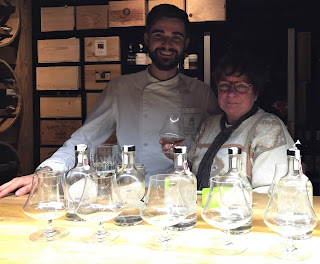Recently I caught the tail end of a radio programme about our eating habits. This got me thinking about how that where we choose to shop, what we choose to eat, when we eat, and where we eat, says so much about our social class.
I cannot ever remember not being interested in food; whether reading about it, preparing it, or eating it; evidenced by my constant battle with my waistline.
I also adore travelling, and having visited or lived in over 50 countries, I always make a beeline for interesting food markets and places to eat.
When it comes to what I put in my mouth, I am lucky in that apart from a few dislikes, the smell of truffles being one, I am not a fussy eater; a spell at boarding school knocked that out of me. Yes, I do like high-end, top notch, award winning, meals, but at the other end of the scale I find that I am just as happy sampling local street food down a sleazy back alley, and I admit to a secret liking for Fray Bentos steak and kidney pie and Heinz tomato soup.
Although I naturally gravitate towards other well-travelled foodies and come from a firmly working-class background, I have, over the years, gained friends from all walks of life. I also like to entertain, a lot, believing that there is nothing like breaking bread together to bring communities together. I find it really sad that in many family households eating together is now very much the exception rather than the norm.
What we call those meals that we do choose to eat says much about us. I always refer to my midday meal as lunch and my evening meal as dinner, with supper reserved for those post-theatre or concert get togethers. On occasion I may partake of a little afternoon tea at around 5pm. I have a constant tussle with my neighbour, who I socialise with regularly, over whether or not she is coming to have ‘supper’, a casual light meal shared by the two of us, or ‘dinner’ which to her means a higher level of formality and an effort to dress up.
Many of those I associate with would naturally call their lunchtime meal dinner, and their evening meal tea. This can cause the odd problem when issuing invitations and I have to take care that my guests know what it is they have been invited for.
The same goes for how and where we shop. My personal frustration comes to the fore when I am unable to find just one place to buy all of the things I need, hence I patronise the whole gamut of options, but never, ever, order online. I like to eyeball what I am buying, choose the latest sell-by date, and take advantage of any special offers. If I am cooking a ‘special’ meal it might be that I need produce to be a certain size. I well remember hand picking new potatoes, strawberries and mushrooms in the local markets when working in New York, and selecting just the right cut of meat or fish. I confess to being an unashamed peeker into other people’s shopping trolleys, on the few occasions I am forced to patronise supermarkets, rather than small independent stores or local producers.
Although I like the appearance, if not the prices, of the food offered by M&S and Waitrose, I find that often it does not live up to expectations. It took me some time to become a Lidl convert, and I love the new wonky vegetables offered by Morrison’s. Letting nature do its work without intervention.
Most people, when on a tight budget, will fill their trolleys up with quick fix, cheap and cheerful options, usually carbohydrates in some form; pasta, pizza, crisps, chips, anything that is quick to prepare and will fill hungry and not very adventurous stomachs.
Likewise, when it comes to eating out, the chain pubs and fast food outlets are always eager to lure people in with their tempting 2-for-1 offers and other deals. Frequented by those with an eye to a bargain, little thought is given to the fact that the food on their plates, piled high, is often of little nutritional value and, despite the bargain prices, not good value for money.
Those with money to spare in their pockets, by virtue of their higher income levels, have more choice about the food they eat.
With cooking skills largely being a thing of the past for many working-class families, where perhaps both adults (if in fact there are two on the scene), are working their socks off to pay the bills, we are becoming obese, with all of the social problems this brings.
I love free food, and at this time of year I have been busy gathering blackberries from the hedgerows, collecting windfall apples and plums and taking in spare produce from neighbours and friends, and having a ball cooking up a storm.
Eating well does not have to be an expensive pastime, but if we are to do anything to combat the rise in obesity, then we need to address the lack of skills in preparing fresh ingredients.
Whilst I do occasionally indulge in the odd pizza, burger, or fish and chips by the coast, warding off the seagulls, such food does not form part of my daily diet.
But then, I am fortunate, I live by myself and can do as I please, most of the time at least.












